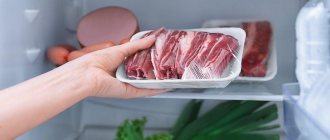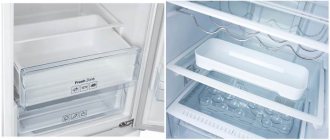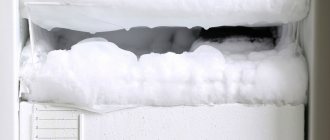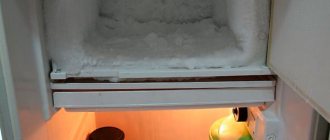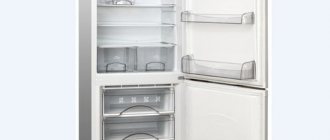Sooner or later, every housewife is faced with the need to defrost the refrigerator. This procedure is also necessary for equipment with a modern No Frost system. If you want your refrigerator to last as long as possible, do not forget to follow the basic rules of caring for it.
The best way to defrost is natural thawing. But this method has a big disadvantage - you have to wait several hours. The process takes from 4 to 12 hours. You can leave it overnight. But often you don’t want to spend so much time, so many other options have been invented that will help significantly speed up the process. I'll tell you about the most popular of them.
Step-by-step instructions for defrosting the refrigerator
Regardless of the model (with the exception of refrigerators with automatic defrosting), defrosting the chambers is carried out according to the general scheme :
- Set the lever to zero and turn off the device. If there is one compressor, unplug the plug; if there are two compressors, it is more convenient to defrost them one by one, transferring food from the disconnected compartment to the working one.
- Remove all food. A cooler bag will help keep them fresh and prevent them from defrosting; in its absence, thermal insulating materials and a large box.
- Remove all shelves and drawers for subsequent washing with detergent.
- Place protection around the device from melted ice and flowing water when washing - old newspapers, rags.
- Clear the cameras of ice. The most gentle method of removal is natural melting, for this it is enough to leave the doors open for several hours. If desired, you can speed up the process using special means.
- Thoroughly wash all refrigerator compartments, including those already cleared of ice crust, using household chemicals specially designed for this purpose or folk remedies, removing dirt and unpleasant odors.
- Wipe all surfaces dry.
- Ventilate the device until completely dry.
- Turn on the refrigerator and let it run without food to make it easier for the compressor to cool the chambers.
- Load clean and dry chambers with products. Try to open the doors as little as possible for the next couple of hours so that the temperature inside the device reaches the set point faster.
Step-by-step algorithm
Every housewife should know how to properly defrost a refrigerator.
Important! Natural thawing is the safest defrosting method.
To do this, we suggest that you read the detailed instructions:
- Set the operating mode control lever to the zero position.
- Unplug the power cord from the outlet. Remember, you cannot defrost a refrigerator that is turned on, this will disrupt the operation of the compressor and damage the unit.
Sealed bags keep food fresh while defrosting
- Completely empty the device of its contents. During the cold season, food can be taken out onto the balcony. When it’s warm, place it in a large basin and cover it with a thick blanket to keep it cold.
- Remove all removable elements (shelves, drawers, containers).
- Check the melt water collection tray. If there is none, place rags and containers.
- Give the ice time to melt. During the natural defrosting process, ice melts on average in 2–8 hours. But in general, how long you need to defrost the refrigerator will depend on the thickness of the ice layer .
- After all the ice has melted, you need to thoroughly rinse the refrigerator and wipe it dry.
- Upon completion of cleaning, return all shelves and drawers to their place, set the temperature and turn on the device.
Important! You can load food back only after the refrigerator has reached the desired temperature.
Use soft cloths to clean the interior surface
You can defrost the freezer in the refrigerator by following the same instructions. But in two-compressor models you do not have to completely turn off the entire unit; it is enough to turn off the power to only one of the chambers.
Causes of ice formation and the need for defrosting
You need to get rid of frost and ice in the refrigerator and freezer regularly . The device cannot constantly maintain cold inside, since when the door is opened, warm air enters inside and the temperature in the compartments rises.
When the degrees rise above normal, the compressor turns on and again reduces the temperature to the required level. The water in the air of the refrigeration chamber freezes, forming snow and ice build-up on the evaporator and the walls of the chambers. Ice disrupts air exchange and forces the compressor to work constantly at full strength, which leads to increased energy consumption.
Important! Incorrect operation of the compressor due to ice crust reduces the service life of the household appliance. Soon you will need either an expensive compressor replacement or the purchase of a new refrigerator.
The main reasons for increased ice formation:
- turning on maximum cooling in hot weather;
- long stay in the “superfreeze” mode;
- breakdown of the air temperature sensor in the chambers;
- breakdown of the thermostat in the evaporator;
- clogged drainage hole (refrigerator with a drip system);
- failure of the ice defrosting mode;
- freon leak (the device works non-stop);
- wear of the rubber seal - warm air enters the chambers;
- clogged capillary pipeline - refrigerant circulation is difficult;
- breakdown of the solenoid valve between the compartments (in two-chamber refrigerators).
Special attention and caution when defrosting and washing requires a rubber seal , if damaged, the process of ice freezing accelerates.
Why is ice dangerous?
All refrigerators have to be defrosted - both with and without auto-defrosting systems. The only difference is the frequency, complexity and duration of the procedure itself. In any case, you can’t do without it.
The biggest mistake a refrigerator owner can make is ignoring the ice problem. This only leads to negative results.
Image gallery
Photo from
Freezer with a thick layer of ice
Ice and non-working freezer
Bowls of hot water in the freezer
Defrosting the freezer using a hair dryer
Ice in the freezer is unsightly, inconvenient and, most unpleasantly, expensive. The build-up interferes with the normal operation of the camera. Its volume is significantly reduced, so products have to be placed further from the walls.
If the product is in the freezer in cling film or a thin plastic bag, the package may freeze to a layer of ice.
You will have to tear it off with force, tearing the shell and sprinkling the floor next to the refrigerator with pieces of ice. A little later, puddles will form and cleaning will be required.
If the refrigerator is not properly cared for, the capacity of the freezer decreases sharply, and food becomes more and more difficult to put in and take out every day. Bags, bags and paper packaging freeze and tear, leaving fragments on the walls of the chamber
The unpleasant appearance and inconvenience of using a frostbitten camera are not the main problems.
A thick layer of ice makes it more difficult to maintain the desired temperature. The refrigerator turns on more often, works longer, worse and consumes additional electricity. It has been noticed that housewives who take care of their freezer in a timely manner pay less for light. We talked about the energy consumption of a refrigerator and saving methods in this material.
A refrigerator compressor with a large amount of ice wears out faster and its service life is reduced. Replacing it is an expensive type of repair, which costs almost half the cost of the device itself.
Timely defrosting of the refrigerator prevents many troubles: from overpayments on electricity bills to the cost of replacing the compressor
There are certain recommendations regarding the frequency of defrosting the refrigerator, but you should focus not so much on theory as on the actual amount of ice.
The reasons and speed of frost formation are different, so sometimes you have to clean the freezer more often than recommended by household appliance manufacturers.
Refrigerator defrost frequency
Often they start defrosting the refrigerator with an impressive “coat” of ice, when the door closes poorly and the food does not fit into the compartment. This applies primarily to older models. Of course, you should not bring the device to this state. The frequency of defrosting is specified in the instructions for the model.
If the instructions have not been saved, then refer to the following dates::
- devices that are not equipped with self-defrosting are cleaned of ice at least once every 2 months. Either after the formation of an ice crust of more than 5 mm;
- a device with a drip or air-drip system is defrosted once every six months;
- A refrigerator with a No Frost system turns off once a year, as moisture can accumulate inside the working mechanism. For washing and disinfection, it turns off when dirty.
It can be useful:
How and what to paint a home refrigerator
How to remove scratches on a refrigerator
How to replace the rubber seal in a refrigerator
Refrigerator that does not need to be defrosted: name
Simply put, these are devices with a NO FROST or FROST FREE system. Now many manufacturers produce such models.
List of devices that do not need to be defrosted:
- Bosch Gold Edition
- Siemens KM40FSB20
- LG GA-B489TGRF
- Liebherr CBNPbs 3756 Black Steel
- Samsung Food Showcase RH60H90203L
- LG GA-M409 SARL
- LG GA-B489 YVQZ
Refrigerator that does not need to be defrosted: name
What not to do when defrosting
By following the recommendations, you will reduce the risk of damage to expensive household appliances to a minimum:
- do not defrost the device in hot weather, since after defrosting the compressor will need to work harder to return to the desired temperature;
- do not treat ice with soda and vinegar, as these products damage rubber and plastic;
- do not peel off the ice with sharp objects - you can easily damage the plastic surface and tubes with freon, causing it to leak;
- When cleaning, do not use abrasive agents that cause scratches and cause rust;
- Do not direct hot air (hair dryer) onto rubber gaskets.
What can't you do?
IMPORTANT!
It is strictly forbidden to use sharp metal objects to remove snow build-up: knives, forks, shovels.
In modern models, such tools can damage the plastic coating, and in older versions, they can damage metal tubes with coolant that are placed externally. Due to the risk of damaging electrical wiring, do not disassemble the rear panel of the refrigerator or attempt to clean it without unplugging it.
Also prohibited are:
- metal brushes, sponges with an abrasive surface and other hard materials that can scratch the surface;
- aggressive chemicals: chlorine, vinegar, citric acid in strong concentration. It is especially dangerous if these products come into contact with rubber seals.
How to avoid mistakes?
Three dangerous defrosting mistakes that can lead to damage to the refrigerator:
- improper use of thermal methods to accelerate the thawing process. A long-term stream of hot air or placing a cup of boiling water will cause plastic to deform or cracks to form on glass shelves ;
- turning on the refrigerator when defrosting or drying the chamber is not complete. In this case, the water accumulated in the cavities will accelerate the appearance of ice, and in some cases lead to breakdown. Operating a refrigerator that has not been completely dried will result in a musty odor, rotten or moldy food;
- pouring hot water over the ice build-up. Due to sudden temperature changes, fragile elements may crack or become deformed.
Defrosting the freezer with the refrigerator on
If properly maintained, older refrigerator models will only form ice in the freezer compartment. In modern models, there is sometimes light frost in freezers, and owners have a desire to quickly defrost only the freezer compartment, without turning off the entire appliance from the network.
This is only possible in two-chamber refrigerators , in which the refrigerator and freezer compartments are equipped with two separate external doors, provided that each compartment operates separately (carefully read the instructions for the model).
The power off button above each camera allows you to turn off one of them without turning off the device as a whole. It is recommended to disconnect other models when defrosting to avoid short circuits and electric shocks.
Useful tips
Whatever defrosting method is chosen, you should first prepare a sufficient number of dry rags. The ideal choice would be old towels, soft fabrics, sponges. A well-absorbing rag must be placed under the tray into which the melt water flows. This will prevent water from getting onto the floor.
When defrosting the refrigerator, you need to consider the following recommendations:
- You cannot start defrosting without turning off the refrigerator.
- After partial thawing, the ice can be removed using a wooden spatula.
Attention! It is forbidden to pick out ice with sharp objects. For example, a kitchen knife. It is so easy to damage the walls, and such damage cannot be repaired.
- When the walls are cleared of ice, as shown in the photo, it is recommended to wash them well with a soapy solution using any dishwashing liquid.
- Before turning it on, wipe the walls of the freezer with a dry towel.
- After turning it on, it is better to let the freezer work for 2-3 hours without food and only after a while fill it with contents. The desired temperature inside will be established only after a day, so you should minimize the number of door openings.
Housewives should take into account that the formation of ice on walls more than 5 mm thick more often than six months may indicate a malfunction of household appliances. The most common cause is a loose fit of the rubber gaskets on the door, as shown in the photo. Rapid ice formation is also caused by hot foods left in the freezer of a two-compartment refrigerator. This disrupts heat exchange in the device, which leads to overheating of the motor.
Before defrosting a freezer or a two-chamber refrigerator, it is recommended that you read the instructions included with the appliance itself, and only then choose the most suitable method for quick defrosting. The methods described above are often used in practice and are considered very effective and efficient.
How to speed up the defrosting process
It often takes too long for a glacier to melt in the freezer. A natural question arises, how to quickly defrost the freezer compartment in the refrigerator.
Quick defrosting methods:
- a plastic heating pad or hot water bottle placed in the freezer;
- a pan of hot water in the freezer (place only on a wooden stand so as not to injure the plastic due to temperature changes);
- spraying hot water from a spray bottle every 15 minutes onto the ice crust;
- Use a cloth soaked in hot water (don’t get burned, it’s better to work with thick gloves) to blot off the ice.
- Use the hot air of a hair dryer to carefully treat the ice.
Is it possible to defrost the freezer with a hairdryer?
To decide whether it is possible to defrost a refrigerator with a hairdryer, the precautions taken when working with it will help. When directing hot air at the ice crust, keep the hair dryer at a distance of at least 30 cm from the surfaces so that the hot air does not deform the plastic. Do not direct hot air at the rubber gaskets, otherwise the dried rubber will crack and allow heat to leak into the chambers.
Reference. Rubber gaskets will last longer if they are lubricated with silicone.
Preparation
The first step is to determine whether the refrigerator needs to be defrosted. As a rule, the manufacturer prescribes such subtleties in the documents (sometimes it also describes tips on how to defrost). If this is necessary, you should choose the right time for defrosting and cleaning the refrigeration unit. You should not start it if there are a lot of products stored inside that have nowhere to be transferred for temporary storage.
The warm season in this case is also not the best option. High air temperature will help with the question of how quickly you can defrost a refrigerator, but it will contribute not only to rapid spoilage of food, but also to the breakdown of individual parts of the refrigerator.
Article on the topic: Do peas and beans need to be stored in the refrigerator?
Defrosting the refrigerator begins with removing food from it and necessarily switching the temperature mode to minimum. After this, you can unplug it from the outlet. It is also necessary to remove the grilles and shelves (if necessary).
Refrigerators such as Indesit usually have special containers for collecting liquid. But if such containers are not provided, you can prepare any other suitable in size. It would also be a good idea to prepare a few rags, which from time to time will have to be used to collect the water that drips onto the floor and to the bottom of the mechanism. It is also advisable to install a container in the freezer.
Cleaning refrigerators with automatic defrosting system
Regular cleaning of ice is necessary for older models of refrigerators .
Modern models are equipped with systems (drip, air-drip or No Frost), in which the cold is distributed evenly. As a result, the question of how to defrost the freezer does not arise, since ice does not form. The water simply flows into the drainage hole along the back wall and evaporates. But if this hole becomes clogged, the system fails.
Therefore, devices with an automatic defrosting system will still have to be turned off periodically just to clean the drainage hole and the evaporator tube from accumulated dirt, as well as to wash and disinfect the device itself.
Important! It is not necessary to unplug and defrost the refrigerator if you are leaving for a short time. Modern models have a Holiday function, or something similar, which allows you to keep food at the minimum permissible temperature in the chambers, while reducing energy consumption.
Features of specific types of equipment
To maintain the functionality of the appliance, you must carefully follow the manufacturer's recommendations regarding defrosting methods. Certain nuances of this procedure may vary depending on the model and technology used.
Read on our website Detailed instructions on how to wash a No Frost refrigerator with your own hands.
With drip defrosting system
Most models with this technology have a warning system for excessive ice accumulation. When activated, you should begin defrosting and cleaning. After unplugging the refrigerator from the socket, you should find a hole for drainage on its front panel and attach the spoon that comes with the device to it. Place a container under this structure; all the melted ice will flow into it.
With air evaporation
Models equipped with this technology have a fan and multiple drainage holes. During the defrosting procedure, all these holes must be cleared of deposits using a soda solution (a tablespoon of baking soda per 200 ml of water). For convenience, it is better to use a cotton swab.
Dual chamber devices
The principle of defrosting such devices depends on how its cameras work. If they are connected to the same compressor, then they should be cleared of ice at the same time. If you have two compressors, you do not need to turn them off at the same time. You can transfer food from one chamber to another and wash them sequentially.
If you have a Bosh two-chamber refrigerator, then here you can read detailed instructions on how to defrost it.
Correctly turning on the refrigerator after defrosting
It is important not only to defrost the refrigerator correctly, but also to turn it on correctly after the process is completed. Once the device has been cleared of ice, washed of dirt and disinfected of mold and bacteria, it must dry thoroughly; to do this, it is left open for several hours.
After drying, the door is closed, the average temperature level is set and the device is turned on. Products are loaded into a dry and clean refrigerator no earlier than after 1-2 hours so that the air and surfaces of the chambers are cooled evenly. After loading the food, it is recommended not to open the doors for another couple of hours to speed up cooling.
